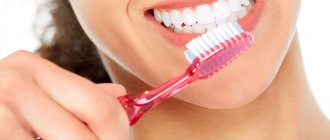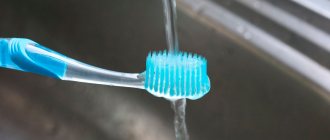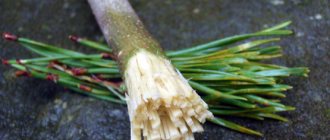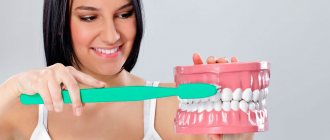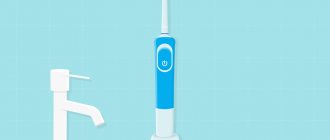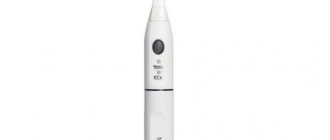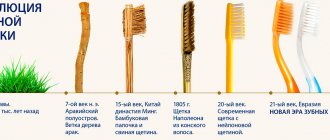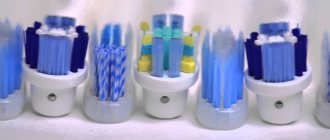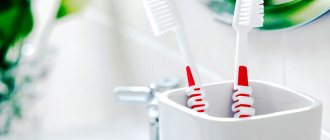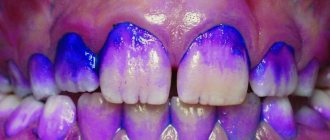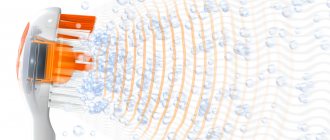Why do you need to brush your teeth?
Prevention of dental diseases and care include daily brushing of teeth with a brush and toothpaste 2 times a day. If you do this rarely, plaque builds up. And when care is performed more often, there is a chance of damage to the enamel.
If regular cleaning is not done, then a problem appears in the form of bad breath, plaque and yellowish discoloration, and dental ailments. Dentists advise brushing your teeth before breakfast, not after. The reason is the presence of a biofilm of plaque and bacteria that remains on the teeth after an overnight rest.
Choose toothpastes without SLS
SLS (or Sodium Lauryl Sulfate) is a substance that dissolves fats and cleans surfaces while forming a thick foam. It is added to most household chemicals, as well as cosmetics and toothpastes.
If in the first case the component effectively fights pollution, then in the second it can be harmful to health. The SLS in the paste oxidizes and forms a film on the mucous membranes, which can cause:
- rash;
- redness;
- irritation;
- peeling;
- allergies;
- sores.
If possible side effects do not bother you, you can say that it is a simple inconvenience. When brushing your teeth, an electric brush mixes saliva with toothpaste into a homogeneous foam mixture. Therefore, if you use a paste with SLS, there will be so much foam in your mouth that you will have to constantly spit it out, which is inconvenient.
Toothpastes without SLS
Weleda natural toothpaste with calendula
Theodent Classic Toothpaste
INNOVA toothpaste Intensive restoration of enamel
Siwak tree sticks
This is another answer to the question of how to brush your teeth if you don’t have a toothbrush. Siwak tree sticks are sold online in vacuum packaging, which includes several pieces. In ancient times they were used for cleaning. One stick can be used for a month.
You just need to follow the general storage rules: keep the box of sticks open to prevent mold and store in a non-humid place. How to brush your teeth without a toothbrush using this device? The procedure is simple: you just need to chew it, having cleared the bark in advance. In “field conditions” you can find a 15-20 cm stick, remove the top skin, after which it is ready for use instead of a brush.
Finger
How can you brush your teeth if you don’t have a brush? If there is nothing, you can use your own finger. First you need to wash your hands. The index finger is used to brush, making circular movements over the teeth and gums. If there is a paste, it is first applied to the finger. You should thoroughly rinse your finger when moving from the lower to the upper teeth.
Design and principle of operation of electric brushes
The device, as well as the design of modern models of electric brushes, are aimed at ensuring a high level of safety and comfort during the process of using the structure, as well as achieving maximum cleaning effect.
Depending on the power supply method, devices can operate from:
- replaceable batteries;
- battery device;
- cord connected to the network.
Perhaps the most convenient and practical are designs that are rechargeable from the mains and equipped with compact batteries.
That is why today most electric brushes are of the battery type.
Let's take a closer look at what is included with these devices..
- Charger , which is connected to the electrical network using cables.
- A hollow stem holder is designed directly for fixing the replaceable head of the structure. In this case, a drive with a spindle of small parameters, as well as a gearbox, is located inside the brush.
- Container for storing brush heads.
- Housing with battery, electric motor, electronic control unit . At the same time, on the outer surface of the device there is a button covered with rubber for setting the cleaning mode and for turning on the electric brush, as well as a charge indicator light.
- Replacement heads for special applications.
- Instructions for the safe operation of an electrical appliance.
Irrigator
This is a special device that helps remove plaque and food debris using water or medicine. According to dentists, using an irrigator instead of floss and brush is much more effective for the entire oral cavity.
The irrigator (aerator) includes a compressor or hydraulic pump, a water container, a set of different nozzles and a comfortable handle. Water or medicinal liquid is supplied into the mouth by a compressor through a nozzle under pressure. This cleaning removes food debris and plaque, improves blood circulation in the gums, and makes them stronger.
The attachments include classic, periodontal, orthodontic, nasal, with a mini-turbine or a spoon for cleaning the tongue. Irrigators can be used for prevention or therapy if a special solution can be used instead of water. There are devices where water is supplied by pulsation or air microbubbles. The device can be used in any environment, it is only important that there is a charged battery or power supply.
Standard
They are also called mechanical. In such brushes, an electric motor, through a transmission element, drives the brush head (nozzle), which can perform both translational (backward) and circular movements (both clockwise and in the opposite direction). It is due to the movement of the head with bristles attached to it that the teeth are cleaned. The rotation speed of different models can vary from 5 to 30 thousand revolutions (movements) per minute.
The advantages of standard mechanical electric toothbrushes include affordable cost and gentle teeth cleaning that does not damage tooth enamel.
But at the same time, in terms of the quality of cleaning, this type of brush is significantly inferior to its sonic and ultrasonic counterparts. See also -
What is the difference between a trimmer and a hair clipper?
Useful tips
There are recommendations that allow you to brush your teeth efficiently:
- You should not start cleaning earlier than 15 minutes after eating. This increases the effectiveness of the paste. After eating some food, for example, spicy or sour, the procedure should be performed no earlier than half an hour later.
- It is advisable to brush your teeth after breakfast and before going to bed at night. Dentists consider this time to be the most suitable for these procedures. Brushing before bed prevents the growth of harmful microorganisms in the mouth, since the salivary glands function weakly at night.
- Cleaning should be done for at least 3 minutes, but do not overdo it. Cleaning for too long (more than 10 minutes) can lead to problems with the enamel, especially when using a paste with a high fluoride content.
- During the day, you need to use toothpicks to remove food particles in the interdental space. The procedure must be performed carefully to prevent injury to the gums and infection in the wound.
- You should independently identify problem areas and give them due attention. For effective care, it is advisable to consult a dentist.
- You should pay attention to the gums, since often beneficial effects for the teeth lead to damage to other areas of the cavity. Bleeding gums can be a symptom of gingivitis.
- Using mouthwashes is not necessary, but it provides a comprehensive approach to prevention.
How to use an electric toothbrush
Believe it or not, many schoolchildren are now excited about brushing their teeth, a daily dental care ritual. We can thank the invention of the electric toothbrush for this phenomenon.
Electric brushes are easy to use, and this is one of their advantages. And although an electric toothbrush costs more than a regular toothbrush, it is worth it if your child (or you) is more enthusiastic about using it for oral health, as it can improve your oral health. Most electric toothbrushes work anywhere from 5,000 to 30,000 strokes per minute, and because of this, a thorough brushing takes less time. Some electric toothbrushes are even more powerful - Oral B's Professional Care 7000 series rotates 40,000 times per minute.
To learn more…
To use an electric toothbrush, simply squeeze a little toothpaste onto the brush head and hold it at a 45-degree angle, just like a regular brush. Then turn on the brush and move the bristles from tooth to tooth. Typically, small brush heads clean one tooth at a time, depending on the size of your teeth. Guide the brush along the front, back, and chewing surfaces of each tooth. Even with an electric toothbrush, you'll have to spend about two minutes brushing to make sure you've brushed every tooth. After cleaning, simply rinse the attachment with water and let it dry.
People with healthy periodontal disease are recommended to brush their teeth using the standard brushing method twice a day (in the morning after breakfast and at night). With the standard method of brushing teeth, the dentition is conventionally divided into 6 segments (molar group, premolar group and frontal group). Teeth begin to be brushed from the left molars of the upper jaw towards the center. First on the upper jaw, then on the lower jaw. The dentition is open.
Algorithm for the standard method of brushing teeth 1. Divide the dentition into several segments: molars, premolars, front teeth. 2. Place the brush at an angle of 45 degrees to the surface of the teeth (dentitions are open). 3. Brush the teeth from the vestibular surface of the upper jaw on the left, performing 10 sweeping movements from top to bottom with the brush, then move on to all other segments. 4. Brush the teeth from the palatal surface of the upper teeth, moving in segments from left to right, making 10 sweeping movements on each one. 5. Brush the teeth of the lower jaw in the same sequence. 6. Brush all surfaces of the teeth with brush movements back and forth, 10 movements per surface. 7. Finish brushing your teeth with circular movements along the vestibular surface, grasping the teeth and gums.
Notes
When performing sweeping movements with a brush, it is first placed at an acute angle from the surface to be cleaned, and then the brush is turned along its axis.
During reciprocating movements, the brush is placed perpendicular to the surface to be cleaned.
On the upper jaw, when cleaning the palatal surface of the front teeth, the toothbrush is placed with the handle down, and on the lower jaw, when cleaning the lingual surface, it is positioned upward. If the sequence of movements with a toothbrush is violated, plaque can be transferred to the interdental spaces.
There are other methods of brushing teeth: the Leonard method, the Reite method, the Bass method, the Smith-Bell method, the Stillman method, the Fones method, the Charter method.
Each of these methods is selected taking into account the condition of the teeth and periodontium. For example, for gingivitis during puberty, it is recommended to use gentle teeth brushing techniques, which include the Charter and Bass method. Charter method. The method is used to clean teeth and gums, and to massage the gums.
In this case, the toothbrush is positioned so that the bristles are at an angle of 45 degrees to the gingival margin. Without removing the bristles, perform gentle shaking or circular movements, while the bristles penetrate between the teeth.
Bass method. The brush is placed at an angle of 45 degrees to the tooth axis, their ends partially penetrate the gingival groove and interdental spaces. Brush movements vibrate back and forth. These two methods help clean the gingival grooves, interdental spaces and contact surfaces of the teeth.
Leonard's method. It is performed using a brush, which is placed perpendicular to the surface of the teeth, making only perpendicular movements in the direction from the gums to the crown.
Reite's method. With the Reite method, the bristles are placed parallel to the axis of the tooth, performing rolling movements from the gums to the crown.
Smith-Bell method. With this method of brushing teeth, the movements of the brush follow the path of food during chewing. The brush is placed perpendicular to the chewing surface and in this position, with gentle pressure and rotation, is advanced to the gum.
Stillman method. The method is performed by pressing on the gingival margin with a brush using weak rotational movements. The bristles are installed so that their ends partially lie at an angle to the axis of the tooth, and partially on the gum.
Fones method. When performing this method of brushing teeth, the bristles are placed perpendicular to the vestibular surface of the tooth, the dentition is closed, and they are cleaned in a circular motion.
What to replace pasta with?
There are situations where there is not only a lack of a brush, but also a lack of toothpaste. What to do in this case? You can find an alternative to pasta at home. The following tools can be used instead:
- Tea tree oil. It is rubbed into the enamel. The product has an excellent whitening effect that occurs naturally. Moreover, the oil does not have a negative effect or destruction properties. It also strengthens enamel, protects against inflammation and disinfects the oral cavity. But you need to take into account the minus of the oil - the presence of a pungent odor and bitter taste.
- Salt. The product is effective for cleaning teeth, as it has an antiseptic, anti-inflammatory and regenerating effect. Salt easily gets rid of bad breath. It is very easy to use: dip the brush in water, apply salt to it, and clean it without sudden movements or strong pressure.
- Baking soda. The product perfectly cleanses enamel, but it should only be used in rare cases, otherwise it damages the teeth. It is advisable to perform such procedures no more than once a week.
- Powdered milk. The product is also ideal for those who have bleeding gums or tartar. It copes well with unpleasant odors, but the effect is not long lasting. Powdered milk should be used as a powder.
- Clay powder. Your teeth will be noticeably whiter after using it. White clay needs to be dried and ground into powder. Then a couple of drops of ether are added. There is ready-made powder in stores.
- Activated carbon. With it, teeth become whiter, pigment spots are also eliminated, the microflora of the oral cavity is normalized and toxins are eliminated. Charcoal gets rid of bad breath. But you shouldn’t use it constantly, because it injures the enamel.
- Hydrogen peroxide. The solution is considered an analogue of professional cleaning. It is not advisable to use it more than once a week. Hydrogen peroxide gets rid of yellowness, eliminates unpleasant odors, and also provides an antiseptic effect.
Therefore, there is nothing to worry about if you don’t have a toothbrush. It can always be replaced with improvised means. Just don’t overuse them, because these methods are only suitable for extreme cases, and full cleaning is still necessary.
Teeth cleaning
Ancient people used dental pickers, the ancestors of today's toothpicks, made of bone and wood. In the 15th century, they began to use sticks with a tuft of bristles at the end; hairs were taken from the neck of a wild boar. Such delights were available only to aristocrats. The shape of the device resembled modern toothbrushes. In the 20th century, bristles were replaced with artificial nylon, creating something that billions of people use today.
According to the rules, teeth are brushed for 5 minutes. This interval is divided into four equal parts, allocated alternately to sections of the jaws:
- Bottom right.
- Top right.
- Bottom left.
- Top left.
Electric toothbrushes, following the path of progress, offer to spend two minutes on the procedure. Advanced models have a built-in digital timer that allows you to carry out the procedure for the allotted time. It takes half a minute for each jaw. To maintain the full time (5 minutes), use an electric toothbrush 2-3 times in a row. Practitioners are satisfied with the result and do not perform repeated cleaning.
The operating principle of an electric toothbrush is based on frequent vibration of the bristles. The energy is taken from the battery and transferred to a miniature motor that performs the operations. The bristles vibrate from bottom to top; just bring the electric toothbrush to your gums and wait for the procedure to complete. Such movements are called rotational. There are electric toothbrushes, where this is combined with the progressive nature of the movements. Such a device shows great efficiency. It’s convenient in the morning, when your eyes are closed, to bring the brush to your teeth and wait until the accessory does the job.
Some brushes combine 3-5 cleaning modes: more of a luxury than a necessity. Don't buy an expensive model right away: personal hygiene items cannot be returned to the store.
